Soon Ukrainian school and college graduates dreaming of becoming doctors will have to decide on the university they are going to apply to. This choice is no less difficult for future doctors from other countries who come to Ukraine to study medicine. No matter what challenges they have faced since the onset of the COVID-19 pandemic and quarantine, the entrants have to decide on the university to entrust their future to.
In order for the entrants to have more information about the quality of education in medical universities, it is necessary to understand which universities provide better training to future doctors.
We analyzed how the 2019 university graduates sat their exams.
When and what exams do medical students take
The students of higher medical schools take two exams.
KROK-1 is the exam to gauge knowledge in major medical areas – anatomy, physiology, histology, pharmacology, pathoanatomy and pathophysiology, etc.
In other words – in those subject areas, without learning which it is impossible to understand the constitution of the human body and its processes.
KROK-1 is sat by the students at the end of their third year.
KROK-2 – is a set of questions on clinical subjects where the doctors in training try to come up with the most appropriate method of diagnostics and treatment of a given pathology.
This exam is sat at the end of the sixth year.
The results of the KROK exams are not an only and invariably fair indicator of the students’ academic progress, but they largely reflect their training level.
Ukrainian students take both KROK exams in the national language, while foreign students can do it in Ukrainian, English or Russian, depending on their language of instruction.
According to Derzhstat, nearly 10 thousand (9,450) doctors-to-be graduated from universities. For the most part, those were the entrants of 2013.
To receive a medical school diploma (specialties in the field “Health Care”) the students had to pass KROK-1 in 2016 and KROK-2 in 2019.
An exception to this rule could be the students taking a year off their studies or failing to complete all program requirements, and returning to studying the same course.
Two thirds of them are citizens of Ukraine (nearly 6.5 thousand) and one third are the students that came to Ukraine to study medicine from more than 30 countries.
O.O.Bogomolets National Medical University was a leader in the number of trained doctors, with V.N.Karazin Kharkiv National University becoming a true “cadre training factory” for foreign nationals.
Graph 1.
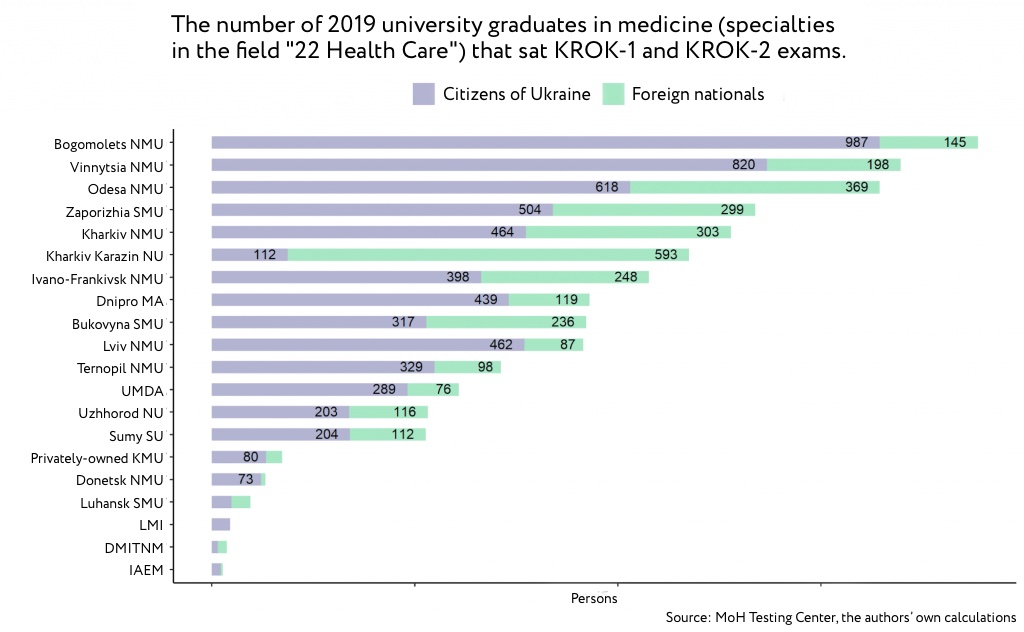
The students had several attempts to pass KROK-1 in 2016. According to law, it is possible to repeat the exam once during the course of the academic year.
However, KROK-2 can only be sat once a year. Those students who failed this exam cannot get their diploma and have to wait one year to resit the exam.
Of the 2019 graduates, nearly 90% passed KROK-1 at the first attempt.
30% succeeded at the second attempt, and 7% at the third attempt (graph 2).
Taking into consideration the high corruption levels and complaints about the quality of medical training, such a percentage seems low.
It is mostly accounted for by the fact that the KROK exams gauge knowledge of the training programs but not the training level as a whole.
Therefore, the KROKs were supplemented with the IFOM exam in 2019 allowing for assessment of the quality of training comparatively to students from other countries.
Unfortunately, this exam was excluded from the schedule of licensed integrated exams in 2020.
In Bukovyna and Sumy Universities, nearly all students (98-99%) pass KROK-1 at the first attempt.
But at Luhansk, Odesa, Kharkiv’s Karazin universities, Lviv Medical Institute, the privately-owned International Academy of Ecology and Medicine, and Kyiv International University, over 15% of students passed KROK-1 at the second/third attempt.
It is worth noting that all the students of Donetsk and Luhansk Universities failing the exam (4% and 16%, respectively) were able to do “their homework” well and pass it at the second attempt.
Graph 2. Percentage of students passing KROK-1 at the first, second and third attempt.
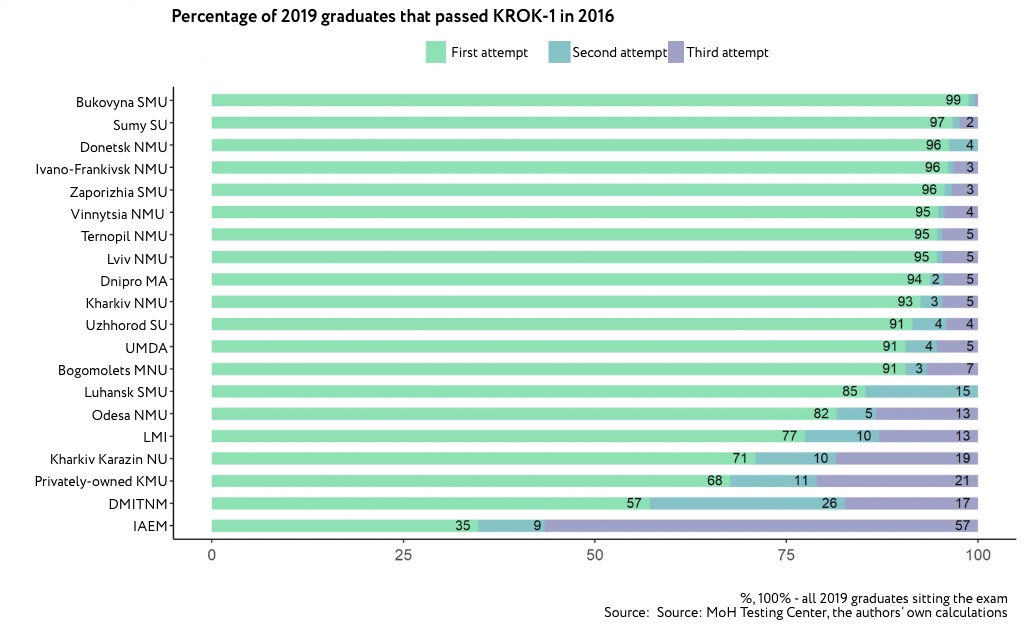
The students from other countries had a bit more difficulty passing KROK-1 at the first attempt. 85% of foreign students succeeded in the exam compared to the 91% of our fellow countrymen.
The success levels of local and foreign students vary by university (graph 3).
Specifically, at Ternopil, Donetsk and Luhansk Universities, almost 100% of foreign students passed KROK-1 at the first attempt.
The local students happened to be less successful.
Graph 3.
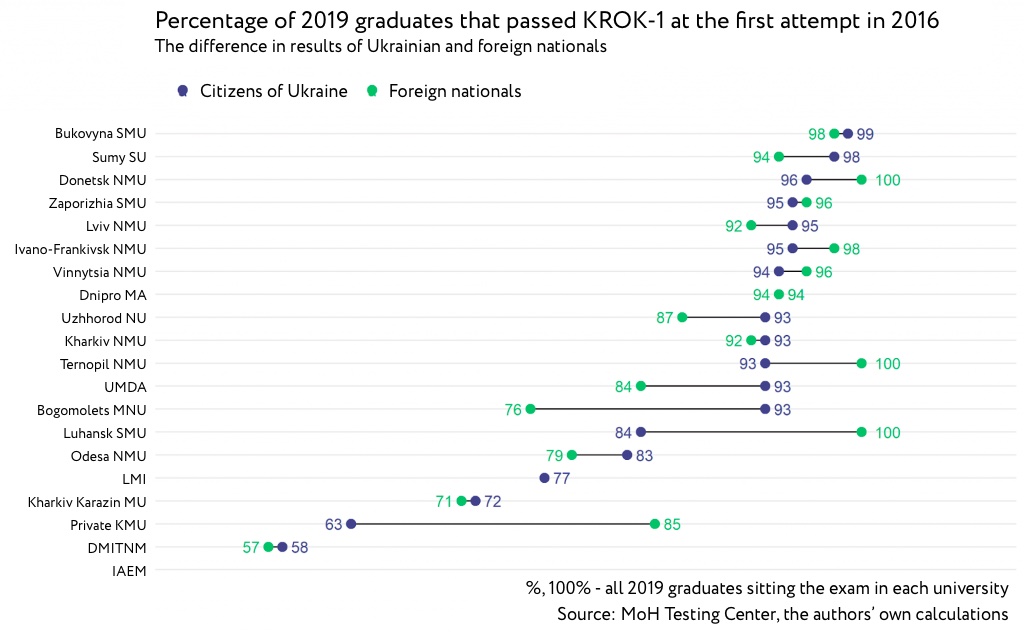
KROK-1 sat by the university graduates in 2016 comprised 200 multiple-choice questions.
The exam’s quantitative result is presented in the multi-point scale of the licensed exam (MLI score) with an average score of 200 and a standard deviation of 20.
To pass the exam in 2016, one had to get the score of 178 or higher, with the maximum exam score being 234.
MLI score may vary from year to year depending on how all the students coped with the questions.
On average, the results of Ukrainian and foreign nationals are more or less the same – with an average MLI score of 204 for both groups.
However, if we consider each university separately, Ukrainians passed the exam better in some of them, with foreigners showing better results in the other (graph 5).
Ukrainians had better KROK-1 results at Sumy University (Ukrainians – 209, foreigners – 199), Bogomolets National Medical University (Ukrainians – 204, foreigners – 198), Lviv University (Ukrainians – 207, foreigners – 202), Uzhhorod University (Ukrainians – 206, foreigners – 202), and Dnipro Medical Academy (Ukrainians – 205, foreigners – 202).
On average, foreigners showed better KROK-1 results at Zaporizhia University (with Ukrainians scoring 203 and foreigners 214), Ivano-Frankivsks University (Ukrainians – 203, foreigners – 214) and Ternopil University (Ukrainians – 203, foreigners – 210), the privately-owned Kyiv Medical University (Ukrainians -189, foreigners – 196) and Kharkiv Medical University (Ukrainians – 202, foreigners – 208) and Kharkiv’s Karazin University (Ukrainians – 193, foreigners – 197).
The difference between the average scores of Ukrainians and foreigners at other universities is not statistically significant.
Graph 4.
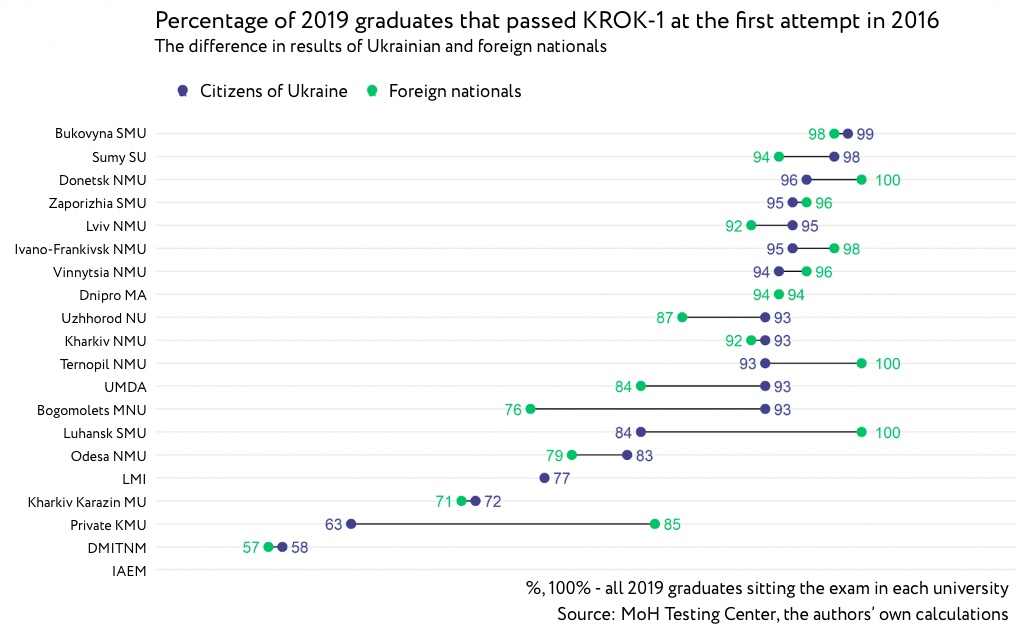
The top three KROK-1 leaders with regard to the local students’ results are Sumy State University, Bukovyna State Medical University and Lviv National Medical University.
Among the outsiders are the privately-owned institutions: International Academy or Ecology and Medicine, and Dnipro Medical Institute of Traditional and Non-traditional Medicine.
As regards KROK-1 for foreign nationals, the best are Zaporizhia, Ivano-Frankivsk and Kharkiv Medical Universities.
The last positions are occupied by the International Academy of Ecology and Medicine, Luhansk Medical University and Sumy State University.
The 2019 KROK-2 exam comprised 200 questions to which the students had to choose one right answer.
As with KROK-1, this exam’s quantitative result is presented in the multi-point scale of the licensed exam (MLI score) with an average score of 200 and a standard deviation of 20. To pass the exam, the students had to get the score of 175 or higher, with the maximum score being 241.
95% of Ukrainian and 90% of foreign students passed the exam at the first attempt (graph 5).
International Academy of Ecology and Medicine, Kyiv Medical University, and Dnipro Medical Institute of Traditional and Non-traditional Medicine have the smallest percentage of local students that passed the exam, with International Academy of Ecology and Medicine, Ukrainian Medical Dental Academy, and Luhansk SMU having the lowest percentage of foreigners succeeding in getting over the threshold.
At the same time, these universities have the lowest average score for KROK-2.
Graph 5.
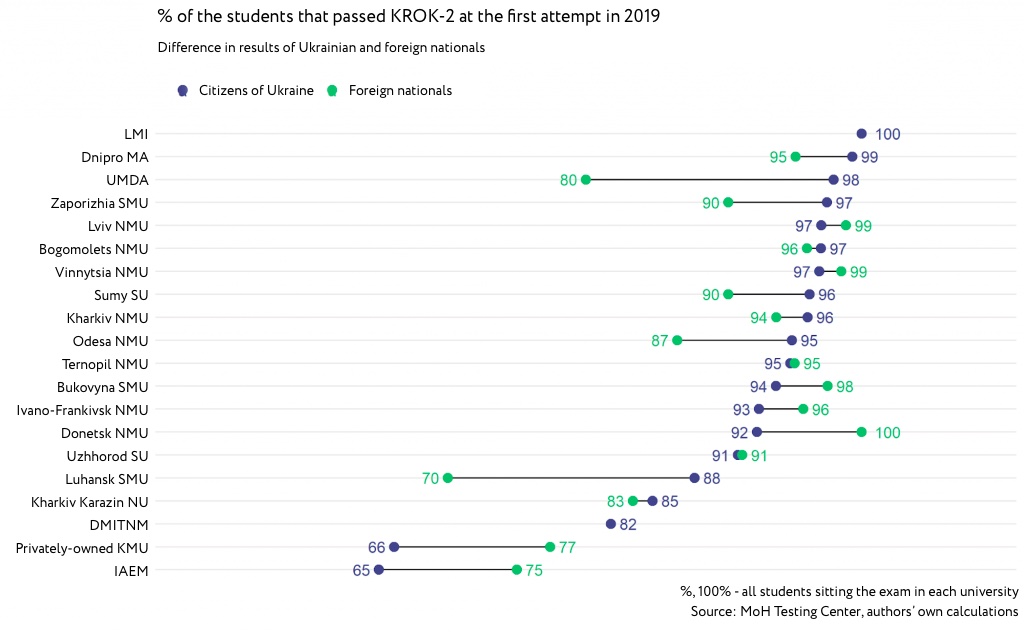
On average, Ukrainian students passed this exam better than foreign students (the score of 201 against 193, see graph 6)
Graph 6.

So, not all students succeed easily in the KROK exams.
Different exam results may be accounted for by the universities’ training programs, lecturer qualification, organization of the training process in the classroom and by the patient’s bed, etc.
Another factor with regards to foreign nationals may be the language barrier.
We will try to study the impact of various universities’ success factors on the students’ education in our future publications.
Attention
The authors do not work for, consult to, own shares in or receive funding from any company or organization that would benefit from this article, and have no relevant affiliations


